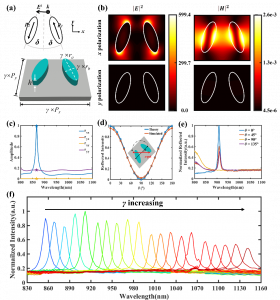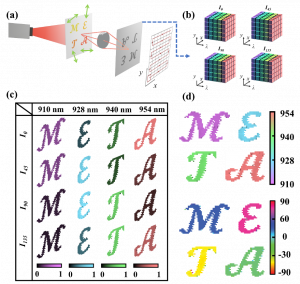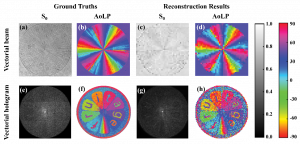High integrated Q-BIC metasurface for convenient and precise spectro-polarization detection

Fig. 1 The design and characteristics of dielectric metasurface supporting Q-BIC mode. (a) The schematic of metasurface unit. (b) Distribution of electric and magnetic fields within x and y polarization. (c) Simulated reflected Jones matrix components of
The proposed multidimensional metasurface offers a novel design approach for next-generation spectro-polarimetric modulation devices.
CHENGDU, SICHUAN, CHINA, July 14, 2025 /EINPresswire.com/ -- Read the full article here: http://www.oejournal.org/oea/article/doi/10.29026/oea.2025.250015Spectral and polarization characteristics, as fundamental properties of light waves, can be used to describe the features of light after interacting with matter, thereby revealing important attributes of the material. For example, the interaction between light and matter can result in specific spectral phenomena such as absorption, dispersion, and even frequency conversion. As a result, spectral information can be utilized for the detection and identification of different material types and compositions. Polarization describes the oscillation pattern of the electric field vector perpendicular to the direction of light propagation, and it can reveal variations in the amplitude and phase of the electric field vector with respect to spatial orientation and propagation direction. When the spatial distribution of a material is anisotropic, it alters the amplitude and phase of different electric field components, making polarization information useful for characterizing the internal structural features and surface morphology of materials. In summary, spectral and polarization information can reflect both the properties and structural characteristics of matter and hold significant application value in fields such as atmospheric sensing, remote sensing, medical diagnostics, and so on.
To enable the simultaneous acquisition of intensity, spectral, and polarization information, researchers have developed various spectro-polarization detection techniques. However, most existing systems are composed of discrete components such as tunable filters, dispersive prisms, gratings, polarizers, and wave plates. These components typically modulate only a single dimension of the light wave and are often large in size due to the cumulative effect of light wave phase. As a result, spectro-polarization detection systems built from these components tend to be complex, posing challenges for optical path alignment and adjustment, and hindering the development of more compact and integrated systems. Moreover, traditional time-division spectro-polarization detection systems require switching between different spectral and polarization elements to extract the information, which compromises temporal resolution and makes it difficult to achieve real-time detection of dynamic scenes.
The research group of Prof. Lingling Huang from Beijing Institute of Technology and Prof. Shumin Xiao from Harbin Institute of Technology developed a multidimensional metasurface supporting quasi-bound state in the continuum (Q-BIC). This monolithic device enables the simultaneous manipulation of 20 wavelength channels and 4 polarization states, significantly exceeding the channel capacity of traditional time-division and amplitude-division systems. Through precise structural parameter design, the device achieves a spectral resolution (λ/Δλ) of 71.03 and a polarization detection error of 4.67°. This metasurface offers a promising solution for the development of integrated and miniaturized spectro-polarization detection systems. Furthermore, the demodulation of spectral and polarization information does not require deep-learning algorithms, endowing the reconstruction with simplicity and stability, and making it well-suited for applications in aerospace, chemical sensing, machine vision, and other fields. The research was published under the title “Spectro-polarimetric detection enabled by multidimensional metasurface with quasi-bound states in the continuum.” in Volume 6 of Opto-Electronic Advances in 2025.
In this work, the metasurface unit cell consists of two elliptical nanopillars with identical geometric dimensions. By breaking the symmetry of the rotation angle, the research team introduced the Q-BIC mode, as illustrated in Fig. 1(a). This mode exhibits high quality factor and narrow bandwidth resonance, and is dependent on the polarization direction of the incident linear polarized light. Moreover, by varying the geometric dimensions of the nanopillars and the periodicity of the unit cell, the resonance wavelength can be tuned.
The team investigated the unit cell's electromagnetic response characteristics and Jones matrix components, verified how the reflected intensity changes with the polarization angle of the incident light, and experimentally measured the reflection spectra under linear polarizations of 0°, 45°, 90°, and 135°, as shown in Fig. 1(b–e). These results demonstrate that the polarization response at the resonant wavelength resembles that of a linear polarizer. Additionally, by increasing the geometric scaling factor γ of the unit cell (as shown in Fig. 1(a)), a redshift of the resonance wavelength can be achieved, thereby enabling different spectral modulation with varying geometries.
Based on these properties, metasurface unit cells with different geometries and orientations can be spatially multiplexed into a single-chip device, achieving highly integrated simultaneous control of the spectral and polarization dimensions of incident light. Owing to the narrowband response of the Q-BIC mode, light intensity at specific CMOS pixels can be directly read, enabling the synchronous acquisition of spectral and polarization information of a target object. To validate the spectro-polarimetric detection capability of the proposed device, the research team built a detection system and performed measurements on targets with different wavelengths and polarization states, successfully acquiring their spectral and polarization images, as shown in Fig. 2. Furthermore, the system was also used to detect a vectorial structured beam and a vectorial hologram with uniform intensity distribution. The results demonstrate that the system can capture polarization information which is not visible in conventional intensity images, further showcasing the ability of the designed metasurface to detect high-dimensional optical field information. The results are shown in Fig.3.
In summary, the proposed multidimensional metasurface offers a novel design approach for next-generation spectro-polarimetric modulation devices, holding great promise for the development of multifunctional, miniaturized, and integrated optical detection systems and their application in platforms such as drones, micro/nano satellites, and mobile electronic devices.
The joint research team comes from the Laboratory of Nanophotonics and Novel Display at Beijing Institute of Technology, and the Micro-Nano Photonics Laboratory at Harbin Institute of Technology (Shenzhen). Their main research areas include the physical mechanisms and functional applications of novel micro/nano optical devices, optical field manipulation, diffractive optics, holography, information optics, new display principles and devices, as well as nano-optoelectronic functional materials and their devices. Prof. Lingling Huang and Shumin Xiao are the corresponding authors of this study.
This work was supported by the National Key R&D Program of China (2021YFA1401200), the Beijing Outstanding Young Scientist Program (BJJWZYJH01201910007022), the National Natural Science Foundation of China (U21A20140, 92050117), and the Beijing Distinguished Young Scholar Program (JQ24028).
Andrew Smith
Charlesworth
+ +44 7753 374162
marketing@charlesworth-group.com
Visit us on social media:
LinkedIn
YouTube
Other
Legal Disclaimer:
EIN Presswire provides this news content "as is" without warranty of any kind. We do not accept any responsibility or liability for the accuracy, content, images, videos, licenses, completeness, legality, or reliability of the information contained in this article. If you have any complaints or copyright issues related to this article, kindly contact the author above.


